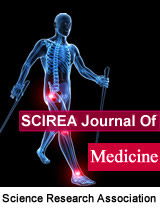Antimicrobial sensitivity and resistance pattern of Bacteria in hospitalized patients with Urinary Tract Infections (UTI)
DOI: 322 Downloads 15431 Views
Author(s)
Abstract
AbstractIntroduction: Urinary tract infection (UTI) is the 1st most common disease in indoor and outdoor patient presenting in urological practice. Aim of our study to assess, the adequacy of the empirical therapy and resistance pattern of bacteria responsible for UTI admitted in Urology Department.Methodology: This is descriptive cross sectional study in which urine samples collected for urine culture & sensitivity from the patients at Urology department CMCTH/SMBBMU Larkana during period of December 2015 to November 2016. Urine culture & sensitivity with bacterial count of 105 CFU/mL and more bacteria were considered positive and all samples were evaluated for sensitivity and resistance pattern of antimicrobial drugs.Results: 150 samples analyzed in which male patients was 103(68.66%) and female patients were 47(31.33%) with male to female ratio 2:1 with mean age 38.34 years SD±7.8. Among all urinary bacterial infections Escherichia coli was the most common organism seen 89(59.33%) patients followed by Klebsiella pneumoniae, Pseudomonas aeruginosa, Staphylococcus aureus, Proteus mirabilis, mixed organism and enterococcus species. Sensitivity pattern of uro-pathogen were excellent in Meropenem, Tazobactam/Piperacillin, Maxipime, Nitrofurantoin, Fosfomycin, Amikacin and Amoxicillin/clavulanic acid. Resistance pattern was seen in cephalosporin, Penicillin, gentamycin and quinolone.Conclusions: As resistance pattern of organism increasing day by day which increasing morbidity and mortality rate so we recommended urine C/S for all patients admitted in urology ward waiting for urological intervention.
Keywords
UTI, Uro-pathogens, Antimicrobial sensitivity and Resistance pattern
Cite this paper
Amanullah Abbasi, Aamir Ali Shaikh, Safiullah Sohu, Mohammad Imran Soomro, Nisar Ahmed Shaikh, Malik Hussain Jalbani,
Antimicrobial sensitivity and resistance pattern of Bacteria in hospitalized patients with Urinary Tract Infections (UTI)
, SCIREA Journal of Medicine.
Volume 3, Issue 1, February 2019 | PP. 1-8.
References
| [ 1 ] | Muhammad Sohail, Mohsin Khurshid, Hafiz Ghulam Murtaza Saleem, Hasnain Javed and Abdul Arif Khan.Characteristics and Antibiotic Resistance of Urinary Tract Pathogens Isolated From Punjab, Pakistan. |
| [ 2 ] | Li XZ. Quinolone resistance in bacteria: emphasis on plasmid-mediated mechanisms. Int J Antimicrob Agents 2005;25:453-63. |
| [ 3 ] | Bader MS, Hawboldt J, Brooks A. Management of complicated urinary tract infections in the era of antimicrobial resistance. Postgrad Med. 2010;122(6):7-15. |
| [ 4 ] | Falagas ME, Polemis M, Alexiou VG, Marini MA, Kremastinou J, Vatopoulos AC. Antimicrobial resistance of Esherichia coli urinary isolates from primary care patients in Greece. Med Sci Monit. 2008;14(2):CR75-79. |
| [ 5 ] | Sharifian M, Karimi A, Tabatabaei SR, Anvaripour N. Microbial sensitivity pattern in urinary tract infections in children: a single center experience of 1,177 urine cultures. Jpn J Infect Dis. 2006;59(6):380-82. |
| [ 6 ] | Mittal R, Aggarwal S, Sharma S, Chhibber S, Harjai K. Urinary tract infections caused by Pseudomonas aeruginosa: a minireview. J Infect Public Health. 2009;2(3):101-11. |
| [ 7 ] | Valiquette L. Urinary tract infections in women. Can J Urol. 2001;8, 1:6-12. |
| [ 8 ] | Franz M, Horl WH. Common errors in diagnosis and management of urinary tract infection. II: clinical management. Nephrol Dial Transplant. 1999;14(11):2754-62. |
| [ 9 ] | Tabibian JH, Gornbein J, Heidari A, Dien SL, Lau VH, Chahal P, et al. Uropathogens and host characteristics. J Clin Microbiol. 2008;46(12):3980-86. |
| [ 10 ] | Livermore DM. Mechanisms of resistance to cephalosporin antibiotics. Drugs. 1987;34,2:64-88. |
| [ 11 ] | Stamm WE. Scientific and clinical challenges in the management of urinary tract infections. Am J Med. 2002;113, 1:1-4. |
| [ 12 ] | Ronald A. The etiology of urinary tract infection: traditional and emerging pathogens. Dis Mon. 2003;49(2):71–82. |
| [ 13 ] | Axel Dalhoff. Global Fluoroquinolone Resistance Epidemiology and Implictions for Clinical Use. Interdisciplinary Perspectives on Infectious Diseases. 2012 (2012),37-40. |

